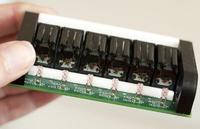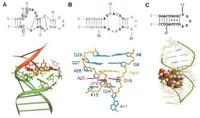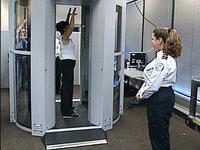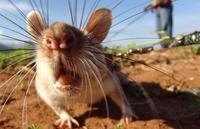-
Trees as contamination detectors
Determining the presence and concentration of contaminants has been an invasive, laborious process; now a Missouri University of Science and Technology team has developed a faster, more economical method of determining such contamination at miniscule levels; the Army has funded additional research for explosive residue detection
-
-
Army seeks long distance explosive detection scanners for people
The U.S. Army is seeking to rapidly deploy long distance chemical detection devices that are capable of detecting explosives hidden on people; ideally, the devices will be able to sense the presence of explosives and chemicals on people standing, walking, or running from as far away as 100 yards; the Army wants to be able to field these capabilities within a year, so it is only considering mature technologies that are ready to be implemented; the request for proposals will close on 6 May
-
-
Russia to employ hi-tech bomb-sniffing dog
In response to a series of terrorist attacks, Russia’s president Dmitry Medvedev has called on Russian military and security services to train more dogs as bomb sniffers; the dogs are trained not only in identifying explosives, but are also trained in carrying walkie-talkies so they can be given instructions from a distance, and to carry portable video cameras for in-building surveillance
-
-
Spate of dry-ice bombs explosions in Long Beach, Calif.
A Long Beach officer is injured after an investigation of a dry-ice bomb left in an alley; a dry ice bomb is a homemade device that uses water, a bottle and dry ice, or frozen carbon dioxide; it can take anywhere from thirty seconds to an hour for a dry-ice bomb to rupture, depending on temperatures outside of the bottle
-
-
Battery-less chemical detector developed
Conventional chemical detectors require an external power source, but Lawrence Livermore researchers have developed a nanosensor that relies on semiconductor nanowires rather than traditional batteries; the device overcomes the power requirement of traditional sensors and is simple, highly sensitive, and can detect various molecules quickly; its development could be the first step in making an easily deployable chemical sensor for the battlefield
-
-
New device uses sniffer bees to detect explosives

The unassuming honeybees have a hidden talent — an even keener sense of smell than anyone first expected — which could make them one of the U.K.’s most ruthless and worst-feared weapons against terrorism; researchers developed a portable handheld sensor that holds thirty-six trained bees gently restrained in six cassettes inside the device; each is taught to recognize a particular odor and associate that smell with a food reward; the researchers have already trained their honeybees to detect a wide variety of explosive compounds and mixtures, including Semtex, C4, PE4, TNT, DMNB, gunpowder, and hydrogen peroxide
-
-
Ultra-sensitive sensor technology detects explosives, cancer
Princeton researchers have invented an extremely sensitive sensor that opens up new ways to detect a wide range of substances, from tell-tale signs of cancer to hidden explosives; the sensor, which is the most sensitive of its kind to date, relies on a completely new architecture and fabrication technique developed by the Princeton researchers; the device boosts faint signals generated by the scattering of laser light from a material placed on it, allowing the identification of various substances based on the color of light they reflect; the sample could be as small as a single molecule
-
-
Spray-on explosives detector
A chemist at Oklahoma State University has developed a spray-on material that detects explosives made from peroxides and renders them harmless; the material is a type of ink that contains nanoparticles of a compound of molybdenum. The ink changes color, from dark blue to pale yellow or clear, in the presence of explosives
-
-
Universal detector made of DNA building blocks

Aptamers are composed of the building blocks of the genetic material DNA; scientists show that aptamers can be used quantitatively to detect and accurately examine multifaceted substances; a method for detecting such diverse substances as antibiotics, narcotics, and explosives - in effect, a universal detector — has been developed by researchers at the Max Planck Institute for Polymer Research in Mainz
-
-
TSA looking for shoe scanning devices
DHS is seeking companies to which it will award a contract for shoe scanners; according to the Office of Federal Business Opportunities, the Shoe Scanning Device (SSD) system currently sought by the TSA and DHS “will be capable of detecting threat objects concealed in footwear without requiring passengers to remove their footwear as they pass through a security checkpoint. These threat objects include a wide variety of military, commercial, and homemade explosives or explosives devices”
-
-
TSA retests body scanners amidst radiation exposure concerns

The Transportation Security Administration (TSA) recently announced that it was retesting all of its full-body scanners over concerns that they were emitting high levels of radiation; maintenance records have shown that some scanners emitted radiation levels ten times higher than expected; TSA says that these increased levels were simply the result of a math mistake and that the machines do not pose a health risk; one type of body scanner in use relies on backscatter X-rays which produce very low levels of ionizing radiation; experts worry about the long-term effects of repeated exposure at low levels
-
-
New technology allows detection of nuclear materials from a mile away
New detection technology would allow illicit nuclear material to be detected from up to a mile away; the technology, developed by the Idaho National Laboratory, will help protect the United States against the smuggling of nuclear materials into the country; field tests will begin this summer
-
-
Explosive-detecting rats to save soldiers' lives

An Oklahoma State University researcher received a $740,000 grant from the Department of Defense to conduct the research into using rats as landmine sniffers; rats have three advantages as bomb sniffers: the rodents, about the size of a small cat, can cover a lot of ground quickly; their acute sense of smell enables them to sniff out land mines, but they are small enough that they do not detonate the mines; also, they do not form attachments to their handlers so anyone could deploy them
-
-
DHS interested in systems for covert body scans
DHS has signed contracts for the development of mobile and static systems that can be used scan pedestrians and people at rail and bus stations and special event venues — apparently at times without their knowledge; DHS moved to develop the technology as part of an effort to bolster the ability of law enforcement personnel to quickly detect concealed bombs and other explosives on individuals
-
-
Wine testing technology to scan for liquids at airports
Scanner technology originally developed at the University of California, Davis, to test wine in the bottle is being re-engineered to tell shampoo from explosives at airports; this means travelers could be able to carry soda cans or full-size tubes of toothpaste through security and onto jetliners in the not-too-distant future
-
- All
- Regional
- Water
- Biometrics
- Borders/Immig
- Business
- Cybersecurity
- Detection
- Disasters
- Government
- Infrastructure
- International
- Public health
- Public Safety
- Communication interoperabillity
- Emergency services
- Emergency medical services
- Fire
- First response
- IEDs
- Law Enforcement
- Law Enforcement Technology
- Military technology
- Nonlethal weapons
- Nuclear weapons
- Personal protection equipment
- Police
- Notification /alert systems
- Situational awareness
- Weapons systems
- Sci-Tech
- Sector Reports
- Surveillance
- Transportation
Advertising & Marketing: advertise@newswirepubs.com
Editorial: editor@newswirepubs.com
General: info@newswirepubs.com
2010-2011 © News Wire Publications, LLC News Wire Publications, LLC
220 Old Country Road | Suite 200 | Mineola | New York | 11501
Permissions and Policies
Editorial: editor@newswirepubs.com
General: info@newswirepubs.com
2010-2011 © News Wire Publications, LLC News Wire Publications, LLC
220 Old Country Road | Suite 200 | Mineola | New York | 11501
Permissions and Policies
